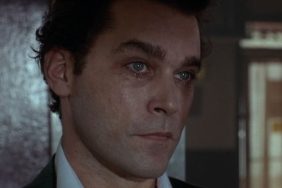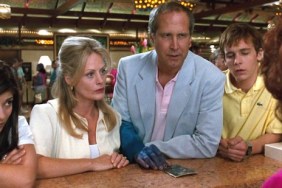Greetings, class. Put down your crack pipes and your beer bongs, stop necking in the back of the classroom, and pay attention. It’s time once more for me, your ersatz… er, I mean erstwhile film professor to offer up a small bit of random film knowledge in this week’s installment of Crave Online’s Free Film School, your 100% student-loan-free university. Today’s lesson: Cross-cutting.
Cross-cutting is: When a filmmaker edits between two scenes of differing actions to imply that they are occurring at the same time, or, at the very least, that they reflect upon one another. This is such a widely-used and elementary film technique that it’s hardly even noticeable these days. Just about every action film you’ll see these days will feature scenes of cross-cutting. To cite a recent example, in Green Lantern, while Hal Jordan (Ryan Reynolds) was first learning his space-cop oath, director Martin Campbell cut to simultaneous scenes of Hector (Peter Sarsgaard) being infected by a yellow virus contracted from an alien corpse. This simple cutting back and forth lent the scenes an eerie parallel, implying that the Hal and Hector were following similar life paths, only motivated by juxtaposed interests. Green Lantern didn’t follow through too well on this relationship (the film was largely sloppy), but that one scene is a good illustration of what I mean.
It’s possible to use simple editing to draw two scenes together in unexpected ways. Have you ever seen two random films back-to-back, and noticed that they seem to color one another? I once saw a double feature of David Lynch’s 2001 film Mulholland Drive and Billy Wilder’s excellent and cynical noir Sunset Blvd., and was struck by how similar they were. Try it sometime. I once paired The Last Emperor with Spice World. Although, to be honest, that one didn’t work out so well. My point is filmmakers have been doing that sort of thematic juxtaposition within films ever since the mid-1910s.
“Oh no,” I hear you cry, “the 1910s? You’re not gonna talk about old, obscure silent films are you?” Yes, I am. Although, to my credit, D.W. Griffith’s 1915 masterpiece Birth of a Nation is one of the most famous films ever made, and was one of the biggest hits of its day.

D.W. Griffith’s ‘Birth of a Nation’ is one of cinema’s greatest accomplishments and biggest shames. It codified many of the filmmaking conventions we take for granted today, and it’s racist as hell.
Ignoring for the time being, the film’s inherent racism, and its unfortunate romanticizing of the Ku Klux Klan, I will cite it as one of the earliest and most effective examples of cross-cutting. Near the end of the film’s 187-minute running-time, there is a scene where our heroine, the supple and innocent Lillian Gish, is trapped inside a cabin being beset and ignited by scowling bad guys and potential rapists. A few miles away, on horseback, our heroes catch wind of what’s going on, and begin racing to her rescue. Griffith, in a fit of unprecedented pique, began cutting back and forth between the peril of our heroine, and the determined race of our hero to save her, ratcheting up the tension, and involving the audience in the drama in a way never seen before.
It’s easy for us to be bored by something so common nearly 100 years later, but it’s something to keep an eye on in the films you see. How does the cross-cutting from one scene back to the previous one cause the scenes to color one another? A filmmaker, if they’re clever enough, and have a talented enough editor, can tell several small stories within a few moments, having the scenes interplay in our minds. There’s more to cinematic storytelling than going straightforward. Let’s lean scenes up against one another, have then support each other.

The final act of Christopher Nolan’s ‘Inception’ takes place over several seconds. And several minutes. And a few hours. Simultaneously. Oh, the power of cross-cutting…
To bring you back from the land of my dry and academic language, I’ll cite another example of fine cross-cutting, this one more recent: Christopher Nolan’s 2010 dream thriller Inception. During the film’s finale, we’re in a swirling and kind of confusing miasma of various levels of dream consciousness (the protagonists have entered a dream, and then entered a dream within that dream, etc.), all of which have different rules of gravity and chronology (each “layer” is taking place at a different speed; one in slow-motion, one in regular, one sped up), but which are all occurring with the the same time frame. What could have been a totally baffling exercise in logic-less dream weirdness is kept afloat by one of the finer recent examples of cross-cutting. The film’s editor, Lee Smith, managed to cut between a remote spy outpost, a posh hotel, and a plummeting van, implying that they were all taking place over the exact same period of time, using the exact same characters, and that there were things at stake in each layer of action. One action in one “layer” effected the actions in all the others.
This video, made by the insightful website Elements of Cinema, illustrates an excellent example of cross-cutting in The Silence of the Lambs (dir. Jonathan Demme, 1991). Not only does the scene give an excellent example of parallel action, but also how the actions of the two scenes relay on one another; when one character realizes what’s happening, the other is suddenty, unwittingly in danger. The makers of this video even included handy captions explaining how the technique is being used, and how it effects the scene dramatically.
Cross-cutting. Remember it.
HOMEWORK FOR THE WEEK: First of all, be sure to watch Birth of a Nation if you haven’t. When you do, be sure to make special note of how the film is edited. If you’ve seen other silent films, note how straightforward the action is in those when compared to Birth of a Nation. Also, be sure to watch Inception, and pay close attention to the film’s entire second half. Pay attention to the chronology, and how seemingly unconnected images play directly into one another.








